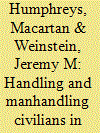|
|
|
Sort Order |
|
|
|
Items / Page
|
|
|
|
|
|
|
| Srl | Item |
| 1 |
ID:
074856


|
|
|
|
|
| Publication |
2006.
|
| Summary/Abstract |
The toll of civil conflict is largely borne by civilian populations, as warring factions target non-combatants through campaigns of violence. But significant variation exists in the extent to which warring groups abuse the civilian population: across conflicts, across groups, and within countries geographically and over time. Using a new dataset on fighting groups in Sierra Leone, this article analyzes the determinants of the tactics, strategies, and behaviors that warring factions employ in their relationships with noncombatants. We first describe a simple logic of extraction which we use to generate hypotheses about variation in levels of abuse across fighting units. We then show that the most important determinants of civilian abuse are internal to the structure of the faction. High levels of abuse are exhibited by warring factions that are unable to police the behavior of their members because they are more ethnically fragmented, rely on material incentives to recruit participants, and lack mechanisms for punishing indiscipline. Explanations that emphasize the importance of local community ties and contestation do not find strong support in the data.
|
|
|
|
|
|
|
|
|
|
|
|
|
|
|
|
| 2 |
ID:
185244


|
|
|
|
|
| Summary/Abstract |
Avoidance of civilian casualties increasingly affects the political calculus of legitimacy in armed conflict. “Collateral damage” is a problem that can be managed through the material production of precision, but it is also the case that precision is a problem managed through the cultural production of collateral damage. Bearing decisively on popular perceptions of ethical conduct in recourse to political violence, childhood is an important site of meaning-making in this process. In pop culture, news dispatches, and social media, children, as quintessential innocents, figure prominently where the dire human consequences of imprecision are depicted. Children thus affect the practical “precision” of even the most advanced weapons, perhaps precluding a strike for their presence, potentially coloring it with their corpses. But who count as children, how, when, where, and why are not at all settled questions. Drawing insights from what the 2015 film, Eye in the Sky, reveals about a key social technology of governance we have already internalized, I explore how childhood is itself a terrain of engagement in the (un)making of precision.
|
|
|
|
|
|
|
|
|
|
|
|
|
|
|
|
|
|
|
|
|